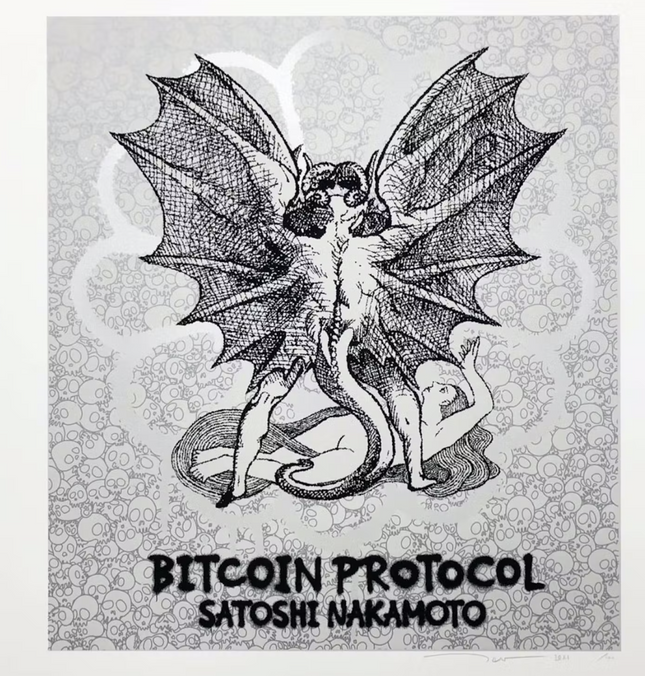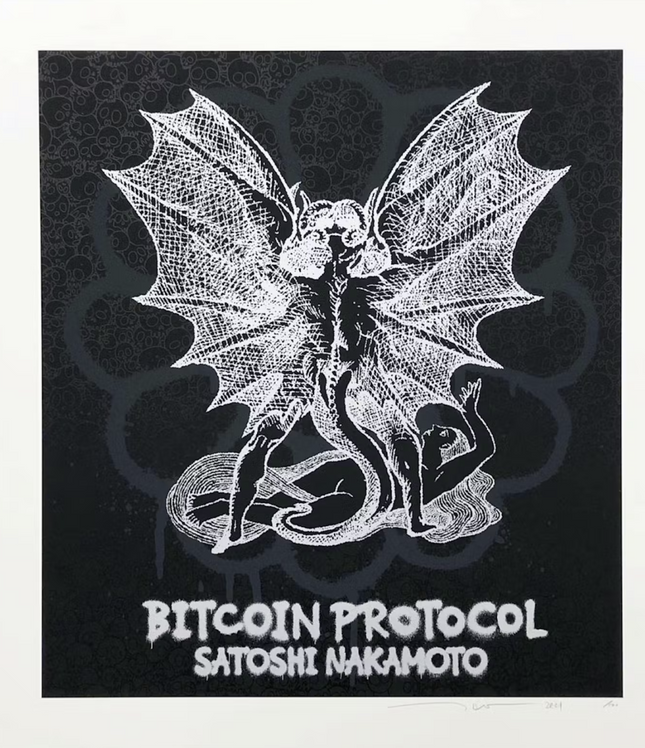
Devil Demons & Satan

Takashi Murakami TM/KK Red Dragon White Platinum Silkscreen Print by Takashi Murakami TM/KK
Red Dragon White Platinum 2-Color Hand-Pulled Limited Edition Silkscreen Print on Fine Art Paper by Takashi Murakami TM/KK Rare Street Art, a Famous Pop Artwork Artist. 2022 Signed & Numbered Limited Edition of 100 Artwork Size 25.2x23.1 Rare Takashi Murakami TM/KK Red Dragon Bitcoin Protocol Satoshi Nakamoto Silkscreen Print Artwork Signed 2022 Edition of 100 In pop culture and street art, few names resonate with as much acclaim and recognition as Takashi Murakami. With an artistic style that effortlessly blends traditional Japanese motifs with modern pop and street art aesthetics, Murakami has carved a unique niche for himself in the art world. One of his recent creations that has garnered widespread attention is the "Red Dragon White Platinum" silkscreen print, a testament to his ingenuity and unparalleled craft. The year 2022 witnessed the birth of this masterpiece, a 2-color hand-pulled limited edition silkscreen print on fine art paper. This technique, while traditional, lends an exquisite texture and depth to the artwork, making each piece a tactile experience as much as a visual one. With a size measuring 25.2x23.1, the artwork is large enough to command attention yet intimate enough to draw viewers in for a closer look. Delving into the intricate details of the "Red Dragon White Platinum," one can't help but be captivated by the majestic portrayal of a red dragon, its wings spread out in all its glory. The meticulous detailing on the dragon, from the scales to the tendrils of smoke, showcases Murakami's attention to detail and his commitment to perfection. Complementing the fiery red of the dragon is the subtle white platinum background, adorned with patterns and motifs that add layers of depth and intrigue to the composition. However, what truly sets this piece apart and anchors it firmly in the contemporary zeitgeist is the mention of "Bitcoin Protocol" and "Satoshi Nakamoto." By integrating these terms, Murakami bridges the worlds of art and cryptocurrency, highlighting the ever-evolving nature of street and pop art. It's a nod to the digital age, to the decentralized world of Bitcoin, and to its enigmatic creator, Satoshi Nakamoto. This blend of traditional imagery with modern concepts is a hallmark of Murakami's style, pushing boundaries and challenging conventions. Produced in a strictly limited edition of just 100 pieces, each "Red Dragon White Platinum" print is signed and numbered by Takashi Murakami, lending authenticity and exclusivity to every piece. Owning one is not just about having a piece of art; it's about possessing a slice of history, a moment captured in time by one of the world's most renowned artists. Takashi Murakami's influence on pop and street art is undeniable, and the "Red Dragon White Platinum" is a shining example of his ability to evolve and adapt to weave narratives that are both timeless and timely. It serves as a reminder of the power of art to reflect society, to challenge norms, and to constantly push the boundaries of what's possible. As the worlds of art and technology continue to intersect and overlap, creations like this will undoubtedly serve as benchmarks, celebrated for their vision, craft, and the stories they tell.
$3,203.00

Takashi Murakami TM/KK Red Dragon Jet Black Silkscreen Print by Takashi Murakami TM/KK
Red Dragon Jet Black 2-Color Hand-Pulled Limited Edition Silkscreen Print on Fine Art Paper by Takashi Murakami TM/KK Rare Street Art Famous Pop Artwork Artist. 2022 Signed & Numbered Limited Edition of 100 Artwork Size 25.2x23.1 Rare Takashi Murakami TM/KK Red Dragon Bitcoin Protocol Satoshi Nakamoto Silkscreen Print Artwork Signed 2022 Edition of 100 "Red Dragon Jet Black 2-Color Hand-Pulled Limited Edition Silkscreen Print on Fine Art Paper" by Takashi Murakami TM/KK is a profound representation of contemporary street and pop art aesthetics. This rare and limited-edition artwork not only stands as a testament to Murakami's unique artistic flair but also embodies the evolution and confluence of various art genres. Takashi Murakami, an iconic name in art, has consistently blurred the lines between high art and low culture. His works, often bridging the realms of fine art, fashion, and pop culture, have garnered international acclaim and have been instrumental in redefining the boundaries of contemporary art. This specific artwork, dated 2022, adds to the artist's illustrious portfolio and exhibits his ever-evolving creative prowess. The "Red Dragon Jet Black" artwork, intricately detailed, stands out with its two-color silkscreen print. The hand-pulled technique showcases the painstaking attention to detail and the personal touch that Murakami lends to each of his pieces. Crafted on fine art paper, it ensures longevity and preserves the intricate details, allowing the colors to shine vibrantly and capture the essence of the subject. Delving deeper into its thematic elements, the artwork is a nod to the world of cryptocurrency, with "Bitcoin Protocol" and "Satoshi Nakamoto" inscribed, representing the revolutionary digital currency and its pseudonymous creator. The amalgamation of traditional Japanese art forms with such contemporary topics exhibits Murakami's penchant for melding different worlds, resulting in pieces that are both topical and timeless. Limited to an edition of just 100, this artwork becomes even more sought-after. Its exclusivity is further heightened by its signature, affirming its authenticity and the artist's direct involvement in its creation. The dimensions, 25.2x23.1, provide ample space for the artwork to breathe, ensuring that each detail, from the fierce dragon to the subtle background patterns, is discernible and appreciated. In the realms of pop art, street art, and graffiti, Takashi Murakami's "Red Dragon Jet Black" is a testament to the transformative power of art. It stands as a beacon of how art can adapt, evolve, and comment on contemporary societal changes while still retaining its essence and roots. This artwork is not just a visual treat but a thought-provoking piece that challenges conventions and pushes boundaries. Through such works, Murakami continues to pave the way for future artists, shaping and influencing the world of art for generations to come.
$3,203.00



